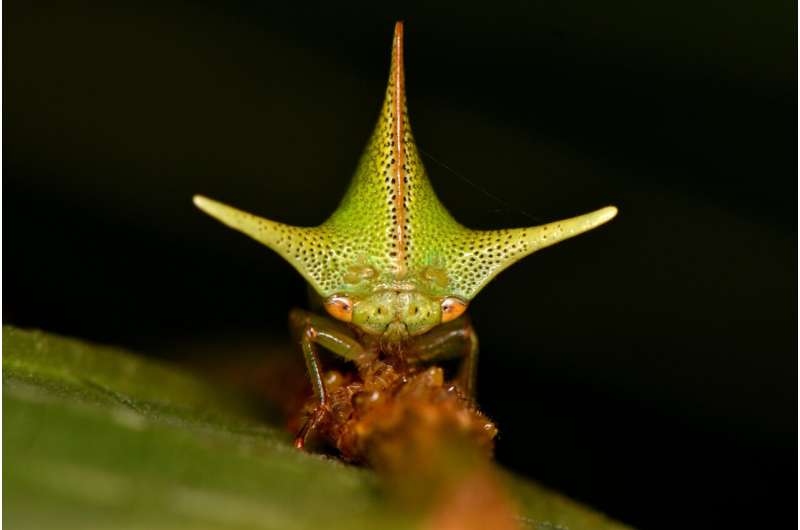Science
Treehopper Research Links Static Electricity to Body Shape Evolution

A recent study suggests that treehoppers, a diverse group of insects, may have evolved their unusual body shapes in response to their ability to detect static electricity. The research, published on August 2, 2025, in the Proceedings of the National Academy of Sciences, was conducted by Dr. Sam England and Professor Daniel Robert from the University of Bristol.
Treehoppers are known for their remarkable morphological diversity, with over 3,000 species exhibiting a wide range of shapes, including horns, spines, and tridents. Despite their curious appearances, the exact functions of these bizarre forms have long puzzled scientists. While certain theories, such as camouflage and mimicry, apply to specific species, they do not account for the entire family.
In their research, Dr. England and Professor Robert explored whether the extreme body shapes of treehoppers enhance their ability to sense static electricity. They based their hypothesis on prior findings indicating that other insects, such as bees and caterpillars, possess the capability to detect electric fields.
The team discovered that predatory wasps produce static electricity, prompting treehoppers to retreat from electric fields. Utilizing computational methods, they demonstrated that the unique morphologies of treehoppers amplify the electric field strength surrounding them, potentially increasing their sensitivity to static electricity.
In a significant finding, the researchers noted that predatory wasps exhibit different electrostatic charges compared to the friendly stingless bees that often protect treehoppers. This distinction suggests that treehoppers can differentiate between allies and threats based solely on electrical signals, supporting the idea that their electroreception is an adaptive trait.
Dr. England remarked, “Our study provides a really exciting launch pad for investigating static electricity as a driver of organismal morphology more generally.” He emphasized that this research opens avenues to explore how other insects and animals with extreme shapes may also be influenced by their electrical environments.
Looking ahead, the researchers plan to investigate how varying treehopper morphologies may adapt to different electrical contexts. Dr. England added, “If we can link treehopper shapes to specific aspects of their electrical ecology, this would strongly support our ideas around static electricity as an evolutionary driver.”
This groundbreaking study not only sheds light on the evolutionary biology of treehoppers but also invites further exploration of the role of electroreception in shaping the forms of other organisms.
For more information, refer to Sam J. England et al, “Electroreception in treehoppers: How extreme morphologies can increase electrical sensitivity,” Proceedings of the National Academy of Sciences (2025). DOI: 10.1073/pnas.2505253122.
-

 Entertainment2 weeks ago
Entertainment2 weeks agoLove Island Star Toni Laite’s Mother Expresses Disappointment Over Coupling Decision
-

 Entertainment2 weeks ago
Entertainment2 weeks agoWoman Transforms Life with Boot Camp, Losing Nearly 9 Pounds in a Week
-

 Lifestyle3 weeks ago
Lifestyle3 weeks agoBring Birds to Events and Dine with Style: Trends This Week
-

 World3 weeks ago
World3 weeks agoCoronation Street Recasts Lily Platt Amid Dramatic Storyline
-

 Entertainment1 week ago
Entertainment1 week agoMary Goskirk’s Injury Raises Questions in Emmerdale Episode
-

 Sports3 weeks ago
Sports3 weeks agoGAA Faces Controversial Decision on DJ Carey Before Final
-

 Entertainment3 weeks ago
Entertainment3 weeks agoBob Vylan Drops Out of European Tour with Gogol Bordello After Controversy
-

 Lifestyle3 weeks ago
Lifestyle3 weeks agoAylesbury Committee Approves Controversial 24-Hour McDonald’s
-

 Entertainment3 weeks ago
Entertainment3 weeks agoJessica Alba’s New Relationship Unveiled with Younger Actor
-

 Science3 weeks ago
Science3 weeks agoAstronomers Discover Giant Exoplanet in Star’s Dusty Surroundings
-

 Entertainment3 weeks ago
Entertainment3 weeks agoKeeley Hawes Takes Risks in High-Octane New Series The Assassin
-

 World3 weeks ago
World3 weeks agoBritish Man, 26, in Critical Condition After 22ft Fall in Ibiza








